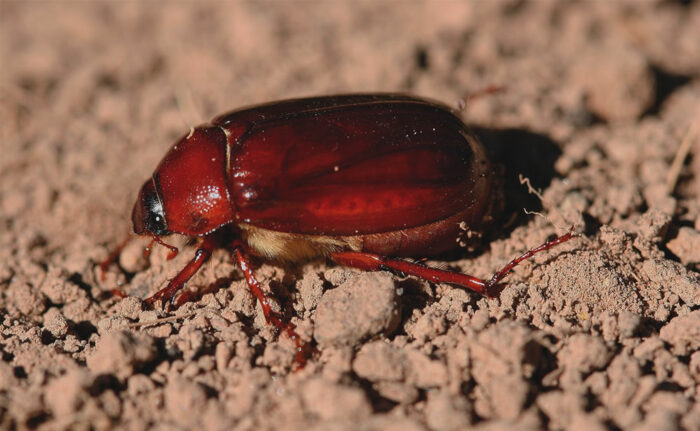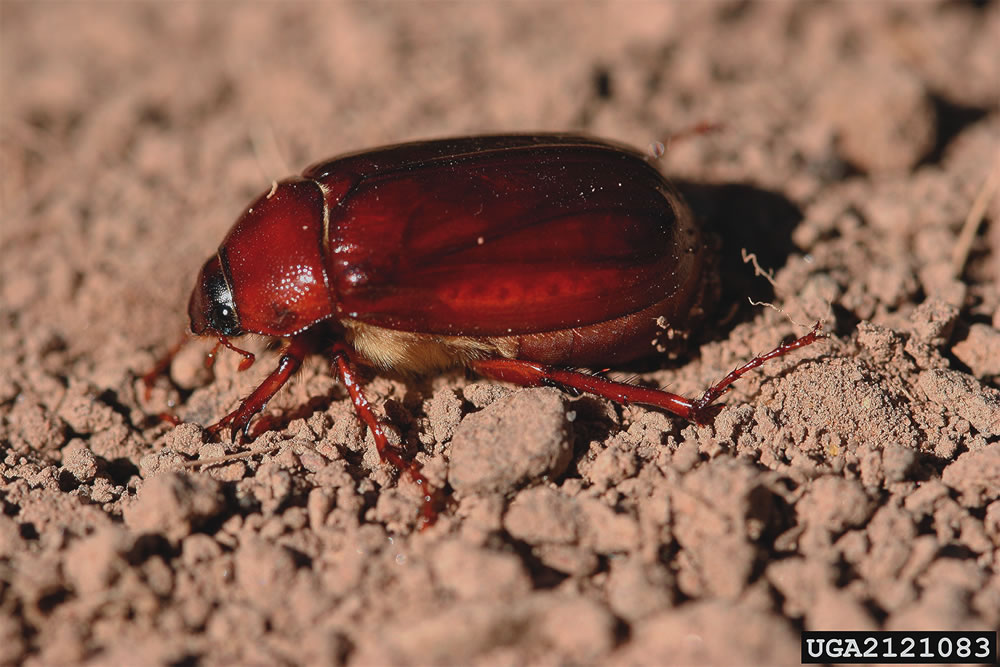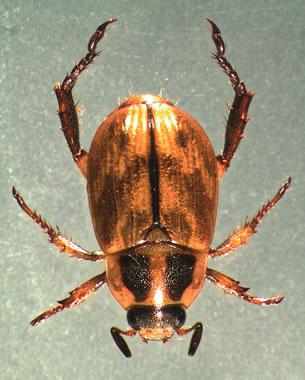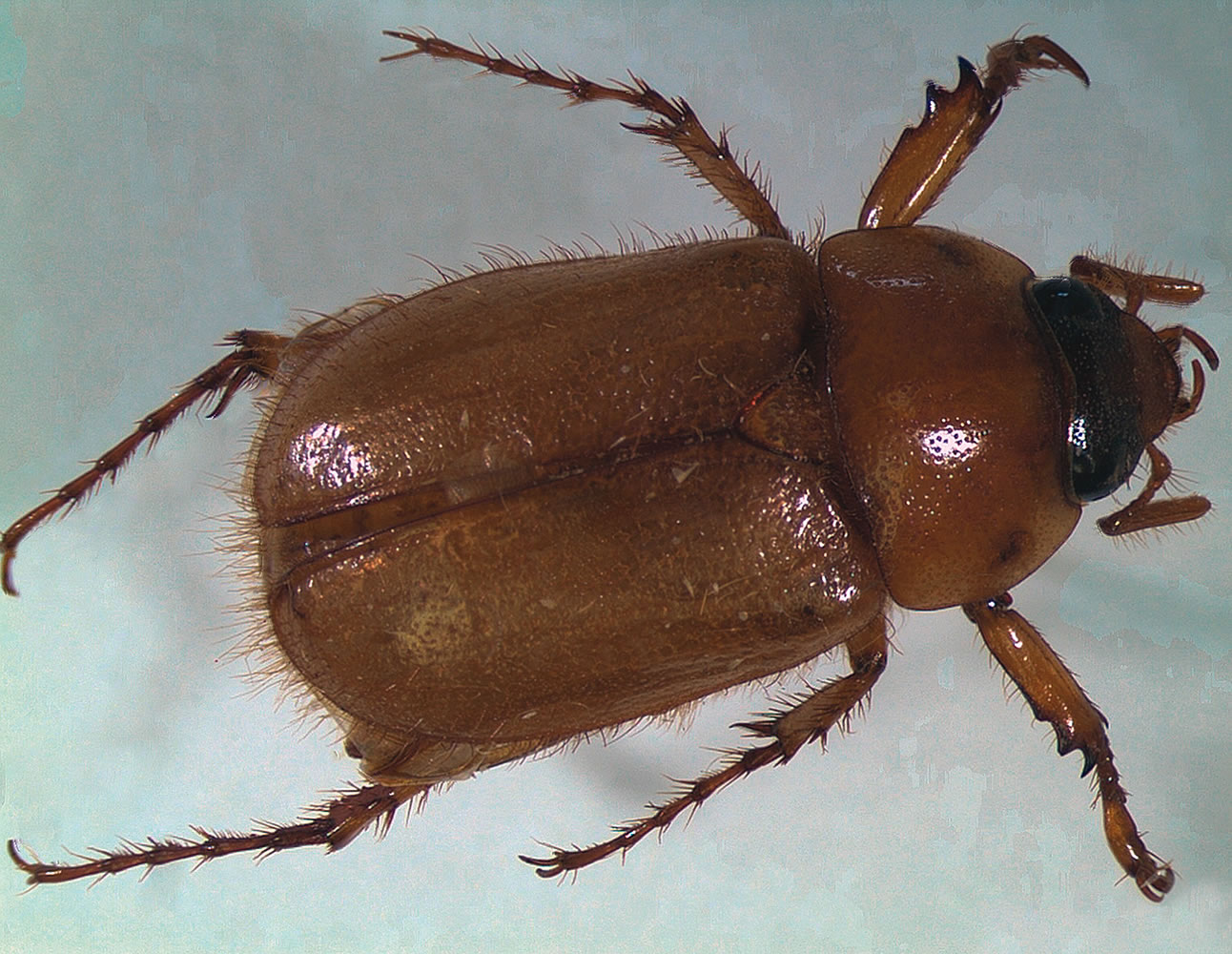How to Control the Beetles That Damage the Garden
Proper insect identification is necessary before choosing a method of prevention

A mere 1 percent of the identified insects on this planet are crop-consuming, disease-spreading, landscape-destroying thugs. The large majority of insects are our allies, helping us control pests, break down organic matter, and pollinate edible crops. But there are some critters that are adept at wielding their wicked ways in our landscapes.
The scarab beetle family (Scarabaeidae) is host to a small posse of such pests. Though most are not garden ruffians, those that are can cause significant injury. And because beneficial insects and pollinators might become collateral damage if pesticides are used, properly identifying the “bad” beetles is a must for every gardener.
The following four members of the scarab beetle family are known for their herbivorous activities; left unchecked, they are capable of causing conspicuous damage to lawns and gardens as larvae and, sometimes, as adults. Managing them without turning to toxic chemicals might involve some effort, but such prevention and control is possible with a bit of forethought.
Japanese beetle (Popillia japonica)

A nonnative member of the family Scarabaeidae, Japanese beetle is a notorious pest in the Northeast. Its range has now expanded to include isolated populations across much of the continental United States.
Characteristics: The adult is metallic green with copper-colored wing covers. It measures about ½ inch in length and is half as wide. Its ground-dwelling larva is a C-shaped, plump, grayish white grub with a light brown head. The larva grows up to 1 inch long and spends the winter several inches below the soil surface.
Damage: The Japanese-beetle grub attacks the roots of turfgrass and many ornamentals. When serious infestations are present—10 or more grubs per square foot of soil—the turf may peel back in a carpetlike fashion and ornamentals may appear wilted. Grub damage is most evident in spring and fall when the grubs are actively feeding in the upper layer of soil.
As an adult, the Japanese beetle consumes over 300 types of ornamentals, beginning in midsummer. It releases pheromones as it feeds, resulting in large numbers of adults coming together to “feed and breed” on the same host plant. Heavy congregations of adult beetles are capable of causing rapid defoliation, though they live for only 30 to 45 days.
Control: Early and frequent hand picking helps prevent massive populations. Knock the adults into soapy water, or squash them. Pheromone- and floral scent–based Japanese-beetle traps might lure far more beetles than they actually trap, causing heavier feeding in areas where the traps are located. Either don’t use the traps or place them several hundred feet from the garden.
TIP: Japanese-beetle grubs cause the biggest problem in lawns that are heavily fertilized and frequently—but shallowly—irrigated. The female beetle needs soft, damp soil to tunnel down and lay its eggs, and the eggs and grubs need moisture to survive. Stop watering, and allow your lawn to go naturally dormant in summer.
May/June beetles (Phyllophaga spp.)

Though there are several hundred species of May/June beetles across North America, only about two dozen are considered pests.
Characteristics: With only a handful of exceptions, adult May/June beetles are ½ to 1 inch long and either black or chestnut brown. Often found congregating around lights on summer evenings, the adult beetle is nocturnal and active for only a few weeks each year.
Damage: The adult feeds on trees and shrubs, including oaks and maples, early in the season, often when leaves are still in bud. As the season progresses, the leaves may appear to have been riddled with buckshot.
Control: Control of adult beetles is rarely warranted because the injury is seldom significant to the health of the plant, and by the time the damage is evident, the beetles have already finished feeding. Most of the beetle’s life is spent underground as a comma-shaped, creamy white, brown-headed grub. damage from May/June beetles appear as irregular patches of yellow turf and loosened sections of sod. The grubs also feed on root vegetables and decaying organic matter.
Be aware of the years when populations are predicted to be the highest in your area, and avoid planting root vegetables during those years. restrict irrigation in July and August as newly laid eggs and young larvae need moisture to survive.
TIP: To deter adult May/June beetles from buzzing around outdoor lights, replace regular lightbulbs with yellow-colored “bug bulbs.” Though they won’t eliminate the beetles, yellow bulbs throw light that is less noticeable to insects of all sorts, reducing the number of beetles you’ll have hanging around.
Oriental beetle (Anomala orientalis, syn. Exomala orientalis)

This Asian introduction has become naturalized from Maine to South Carolina and west to Wisconsin. The adult Oriental beetle emerges in late June through July and is active for two months.
Characteristics: The Oriental beetle is similar in size to the Japanese beetle but is straw colored with irregular dark blotches on its wing covers and two black spots on its thorax.
Active only at night, the adult beetle feeds on the flowers of roses, phlox, petunias, zinnias, irises, and daisies in addition to skeletonizing leaves and eating holes through developing fruits.
Though that sounds intimidating, the adult Oriental beetle seldom causes significant damage.
Damage: The grub of this herbivorous insect can cause substantial injury to the roots of plants, including turfgrass, ornamentals, and small fruits of many types. Often blamed on the more visible Japanese beetle, the damage caused by the Oriental-beetle grub generates a patchy brown lawn, particularly in late summer and fall. Other types of plants injured by this grub quickly wilt and die. To distinguish this grub from other scarab species, you might want to consider sending a sample insect to your local extension service for identification.
Control: To trap adult beetles, invest in a species-specific pheromone trap. These catch-can traps are intended to lure male beetles and disrupt mating cycles. The traps are installed in the ground with only the catch funnel exposed. Note that these are not the same traps (or the same pheromone lures) used to attract Japanese beetles.
TIP: To stave off excessive damage from Oriental beetles, allow your lawn to remain 3 to 4 inches tall.
Northern masked chafer (Cyclocephala borealis)

Endemic to North America, the northern masked chafer is found across the Northeast. A similar species—the southern masked chafer—is more common in the southern states, and several other closely related chafer species are regionally distributed across the continent. All chafer species have similar life cycles and habits, no matter which part of the continent they call home.
Characteristics: The adult northern masked chafer beetle measures ½ inch long and ¼ inch wide. It is shiny brown with a dark “mask” across its head and a single dark spot on each side of the pronotum (the body segment behind the head). It emerges in late June and actively breeds for about a month. It is nocturnal, and a male can be found flying 1 to 2 feet above the soil surface during nighttime hours as it searches for a mate.
Damage: The larva of the northern masked chafer feeds on the roots of cool-season turfgrasses, while the southern species attacks warm-season and transitional grasses; the grub also feeds on organic matter and thatch. Its physical appearance is nearly identical to other white grub species. Its damage is most severe in late summer when its feeding readily separates turf roots and causes the sod to lift up in patches. Infested lawns will remain wilted even after irrigation or rainfall.
Control: To trap adult chafer beetles, hang a light about 2 feet above the ground in early July and position a pail or kiddie pool filled with water on the ground beneath it. The beetles will fly to the light and land in the water, where they can be collected and disposed of the following morning.
TIP: Well-maintained, highly mown turf can tolerate infestations of up to 20 chafer grubs per square foot. Damage is often more severe under lighted areas as the nocturnal adults are attracted to lights. Turn outdoor lights off at night, or replace white lightbulbs with yellow ones.
Pest control
Biological controls
Beneficial nematodes (Heterorhabditis bacteriophora)
Beneficial nematodes are microscopic enemies of the beetle grubs. Applied in late spring, when the soil temperature is above 60°F, these smooth, wormlike creatures seek out and kill host insects throughout the growing season. Because nematodes are living organisms, be sure to purchase fresh stock from a reputable source and store them according to label instructions. This species of nematodes is not winter hardy and should be reapplied on an annual basis. As beneficial nematodes perform best in moist soil conditions, soil or turf should be irrigated both before and after application. Use distilled water to mix the solution, and apply the spray in the evening to give the nematodes time to burrow down into the soil before the sun rises. distilled water is best because the soluble salts and chlorine in tap water can be detrimental to the nematodes. A few weeks after application, look for reddish brown grubs—a sure sign that the nematodes are doing their job.
Milky spore (Paenibacillus popilliae)
Milky spore is a bacterium that’s applied to the soil in either a powdered or granular form. The Japanese-beetle grub consumes the spores which then go on to reproduce within the body of the grub, eventually killing it and releasing more spores. Milky-spore disease only affects Japanese-beetle grubs. It is best applied in late August, when grubs are actively growing and located in the upper layer of the soil. While the effectiveness of milky spore in cold climates is the subject of debate, it has been effective for many parts of the country. Check with your local extension agency to determine if it is recommended for your area.
Biological pesticides
Neem
Biological pesticides derived from the tropical neem tree disrupt the feeding of adult Japanese and Oriental beetles. Applied to foliage in a liquid form, neem-based products should not be used when pollinators are actively foraging as it might also kill these beneficial insects. As with all pesticides, be sure to follow label instructions.
Spinosad
Biological pesticides made from spinosad are great at targeting leaf-munching beetles of all types, including members of the scarab beetle family. Effective against any chewing insect (including many types of caterpillars), spinosad-based products are created by fermenting a species of bacterium. When the pest insect consumes or comes in contact with the product, it disrupts the insect’s nervous system, eventually causing death. Do not use spinosad when beneficial insects are active, and follow all label instructions.
Fine Gardening Recommended Products

A.M. Leonard Deluxe Soil Knife & Leather Sheath Combo
Fine Gardening receives a commission for items purchased through links on this site, including Amazon Associates and other affiliate advertising programs.






Comments
In the last 2 years my garden has slugs,how do i get rid of them,do i leave my garden unplanted for a year ????
Thanks for the great article like to jumblesolver play it forever.
Log in or create an account to post a comment.
Sign up Log in